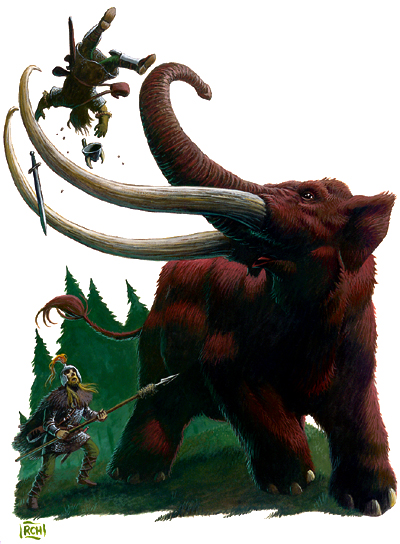

FREQUENCY: Common
FREQUENCY: Common ([Cold
Wilderness Forest], [Cold Wilderness Plains]) * near arctic <>
FREQUENCY: Uncommon ([Cold
Wilderness Hills], [Cold Wilderness Swamp]) * near arctic <>
FREQUENCY: Rare ([Cold Wilderness
Mountains], [Cold Wilderness Desert]) * near arctic <>
FREQUENCY: Common ([Temperate
Wilderness Forest], [Temperate Wilderness Plains])
FREQUENCY: Uncommon ([Temperate
Wilderness Hills], [Temperate Wilderness Swamp])
FREQUENCY: Rare ([Temperate
Wilderness Mountains], [Temperate Wilderness Desert])
FREQUENCY: Very rare ([Temperate
Wilderness Plains])
NO. APPEARING: 1-12
ARMOR CLASS: 6
MOVE: 15"
HIT DICE: 12
% IN LAIR: Nil
TREASURE TYPE: Nil
NO. OF ATTACKS: 5 ~ 9
DAMAGE/ATTACK: 2-16 (tusk)
/ 2-16 (tusk) / 2-12 (trunk) / 2-12 (forefoot) / 2-12 (forefoot)
SPECIAL ATTACKS: Nil
SPECIAL DEFENSES: Nil
INTELLIGENCE: Semi-
ALIGNMENT: Neutral
SIZE: L (10' tall)
LEVEL/X.P. VALUE: VII |
2000 + 16
SAVES: 7.8.9.8.10
Mastodons dwell in nearly
any climate, from near arctic to tropical.
These huge
herbivores are distantly related to elephants, but
their body is somewhat lower and longer.
They are common on Pleistocene
plains.

Their tusks are of the same
weight and value as those of elephants.
<Elephant tusks have
a value of 100 to 600 gp value each.>
<Each gp of value equals
one-quarter pound of weight.>
<DMG:
ivory is worth 3-6 g.p. per pound>
Combat:
Although the mastodon has 5 attack modes (2 tusks, 1 trunk, 2 forefeet),
they cannot employ more
than 2 of them at one time against a single opponent.
For details of attack limitations
and other data see
Elephant.
<They attack by means
of a stab with two tusks, a grab and squeeze with their trunk, and then
two tramplings with their front feet.>
<One opponent can be
subject to no more than two of these attacks at the same time but several
opponents can be fought simultaneously -- 6 or more man-sized opponents
for example.>
<Ogre-sized opponents
will not be affected by trunk attacks.>